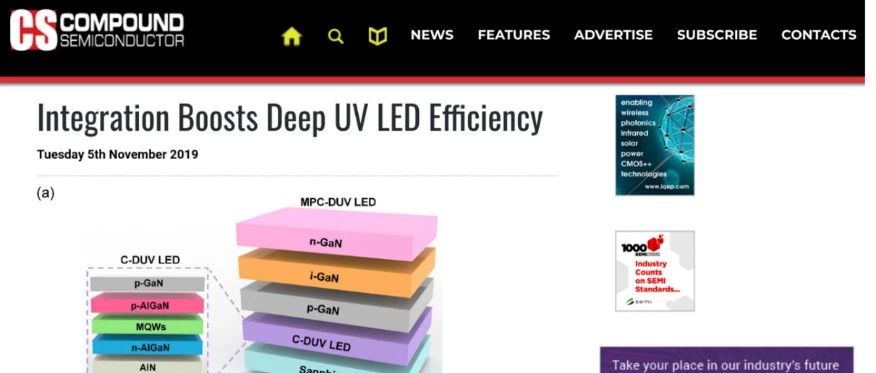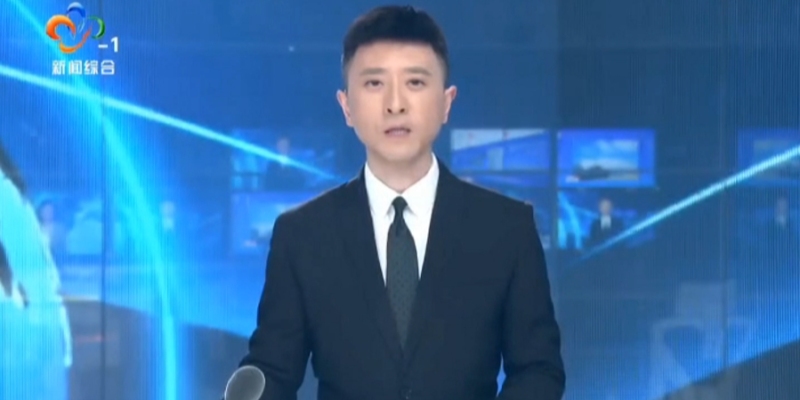The research and development team of UVLEDTEK has reported on the progress of ultraviolet light-emitting chips in authoritative international semiconductor publications
Leading technology, superior products

Semiconductor deep ultraviolet light-emitting diode chip for single-chip integrated photomultiplier converter
Monolithic integration of deep ultraviolet LED with a multiplicative photoelectric converter
The R&D team led by Chen Changqing and Dai Jiangnan has integrated the p-i-n detection structure on a single chip into a deep ultraviolet LED chip for the first time, achieving carrier circulation injection and light multiplication amplification functions, and achieving the highest international electro-optical conversion efficiency value of 21.6%
For a long time, although semiconductor deep ultraviolet LED technology has been widely regarded, its photoelectric conversion efficiency has never exceeded 10%, and it is difficult to move forward in the primary stage of commercial application. Its energy saving, environmental protection, portability, and long lifespan make it widely applicable in medical phototherapy, sterilization and disinfection, air purification, confidential communication, and gas detection, and its market potential cannot be released
In response to this, the research teams of H. Hirayama from the Institute of Physical Chemistry in Japan and C. Kuhn from the Technical University of Berlin in Germany have proposed various methods, such as using electron blocking layers to suppress electron leakage and using tunneling junctions instead of P-type aluminum gallium nitride layers to improve hole injection efficiency, but have not made breakthrough progress
The research and development achievements of Chen Changqing and Dai Jiangnan's team have solved this international problem
Single chip integration technology is the integration of two or more devices or functional structures into a single chip, and the use of their interactions to improve device performance. Essentially, this system level innovation can build a new device environment and achieve a 'system on chip'. The research team led by Chen Changqing and Dai Jiangnan proposed a new idea of introducing single-chip integration technology, which involves in-situ growth of p-i-n gallium nitride detection structure on deep ultraviolet LED epitaxial structure (MPC-DUV LED: Monolith Integration of Deep Ultraviolet LED), achieving chip devices with carrier circulation injection and light multiplication amplification functions
Through long-term research and exploration, the team led by Chen Changqing and Dai Jiangnan innovatively applied the p-i-n detection structure to deep ultraviolet LED chips, which can absorb the deep ultraviolet light emitted by the active region of the quantum well below 280 nm and convert it into new electron hole pairs. Under the action of external high voltage, the generated electron hole pairs undergo separation, and the hole carriers drift in the direction of the quantum well under the action of the electric field, and are re injected into the quantum well
Research has found that under low current, traditional DUV LED chips operate in a current driven mode, and their output power increases linearly. Unlike MPC-DUV LED chips, which operate in a voltage driven mode, their output power increases exponentially
The study further revealed the mechanism by which MPC-DUV LED chips achieve ultra-high conversion efficiency under low current conditions. Through APSYS simulation calculations, the electric field in the i-GaN layer can reach 5 × 106 V/cm, exceeding the threshold electric field of the Geiger mode in gallium nitride materials (2.4~2.8 × 106 V/cm). Therefore, there is a high probability of collision ionization occurring in the depletion layer, resulting in high gains of tens or even hundreds of times, thereby achieving an increase in the number of hole carriers
During the entire photoelectric cycle, electrons and holes in the quantum well recombine and emit light. Some deep ultraviolet photons escape from the bottom of the device, while others enter the MPC structure and are absorbed. High energy deep ultraviolet photons excite the gallium nitride material to produce corresponding electron hole pairs, which separate under an applied voltage. The holes collide and ionize under the strong electric field in the depletion region, multiply multiple times, and are re injected into the quantum well, where they undergo new radiation recombination with the existing electrons in the quantum well. This cycle ultimately greatly improves the efficiency of carrier injection
Since joining the Wuhan Optoelectronics National Research Center at Huazhong University of Science and Technology in 2008 (formerly the Wuhan Optoelectronics National Laboratory (under construction)), the team led by Chen Changqing and Dai Jiangnan has been dedicated to exploring and researching semiconductor deep ultraviolet light-emitting chip devices
In recent years, high-quality AlGaN epitaxial core materials have played an important role in the epitaxial growth of AlGaN (AlN) core materials (Crystengcomm, 21, 4072-4078, 2019; Applied Physics Letters, 114, 042101, 2019), chip design (ACS Photonics, 6, 2387-2391, 2019; IEEE Electron Device Letter, 2948952, 2019; Optics Express, 27, A1601-A1604, 2019), and device fabrication (ACS Applied Material Interfaces, 11, 19623-19630, 2019; IEEE Transaction on Electron). A series of scientific research has been conducted on devices (65, 2498-25032018) and exploration of new structures and mechanisms (Nano Energy, 104, 181, 2019; Optics Letter, 44, 1944-1947, 2019)
10 papers have been published in the JCR Zone of the Chinese Academy of Sciences, and 12 national level projects have been approved (including 2 projects (including sub projects) of the National Key Basic Research Development Program 973 Program (N0.2010CB923204, 2012CB619302), 1 sub project of the National Natural Science Foundation of China Major Special Project (N0.10990103), 3 research and development projects (including sub projects) of the National Key Program (No. 2018YFB0406602, 2016YFB0400901, 2016YFB0400804), 4 general fund projects (No. 61774065, 60976042, 61675079, 61974174), and 2 youth fund projects (No. 51002058, 61704062)
Paper link
https://pubs. acs. org/doi/abs/10. 1021/acsphotonics. 9b00882
https://www.sciencedirect.com/science/article/pii/S2211285519308882? via%3Dihub
Column report link
http://www. semiconductor-today. com/news_items/2019/oct/kaust-301019. shtml
https://compoundsemiconductor. net/article/109321/Integration_Boosts_Deep_UV_LED_Efficiency
